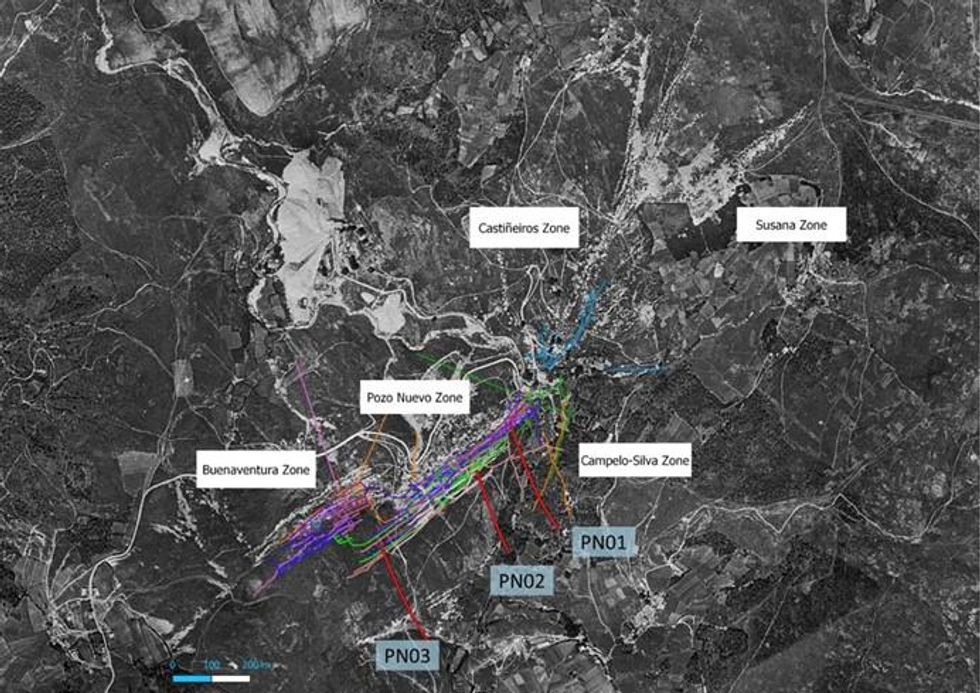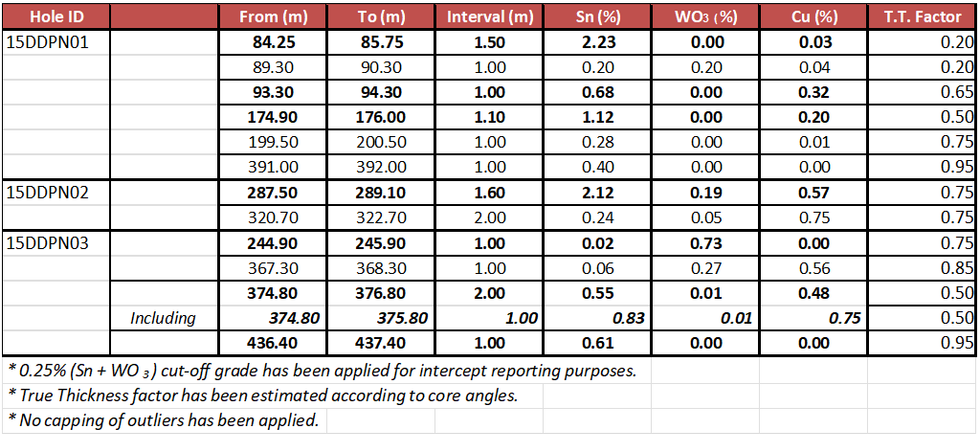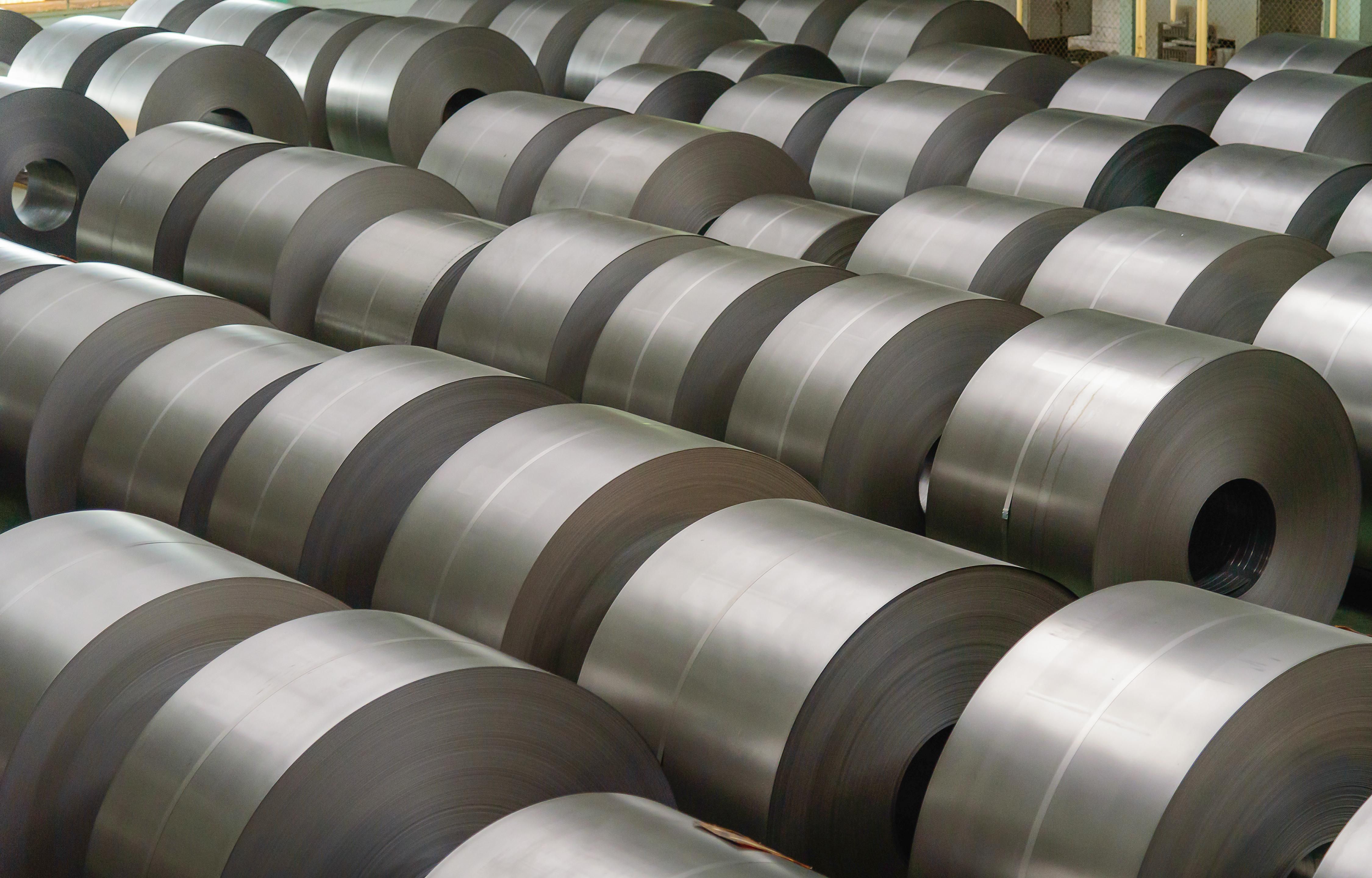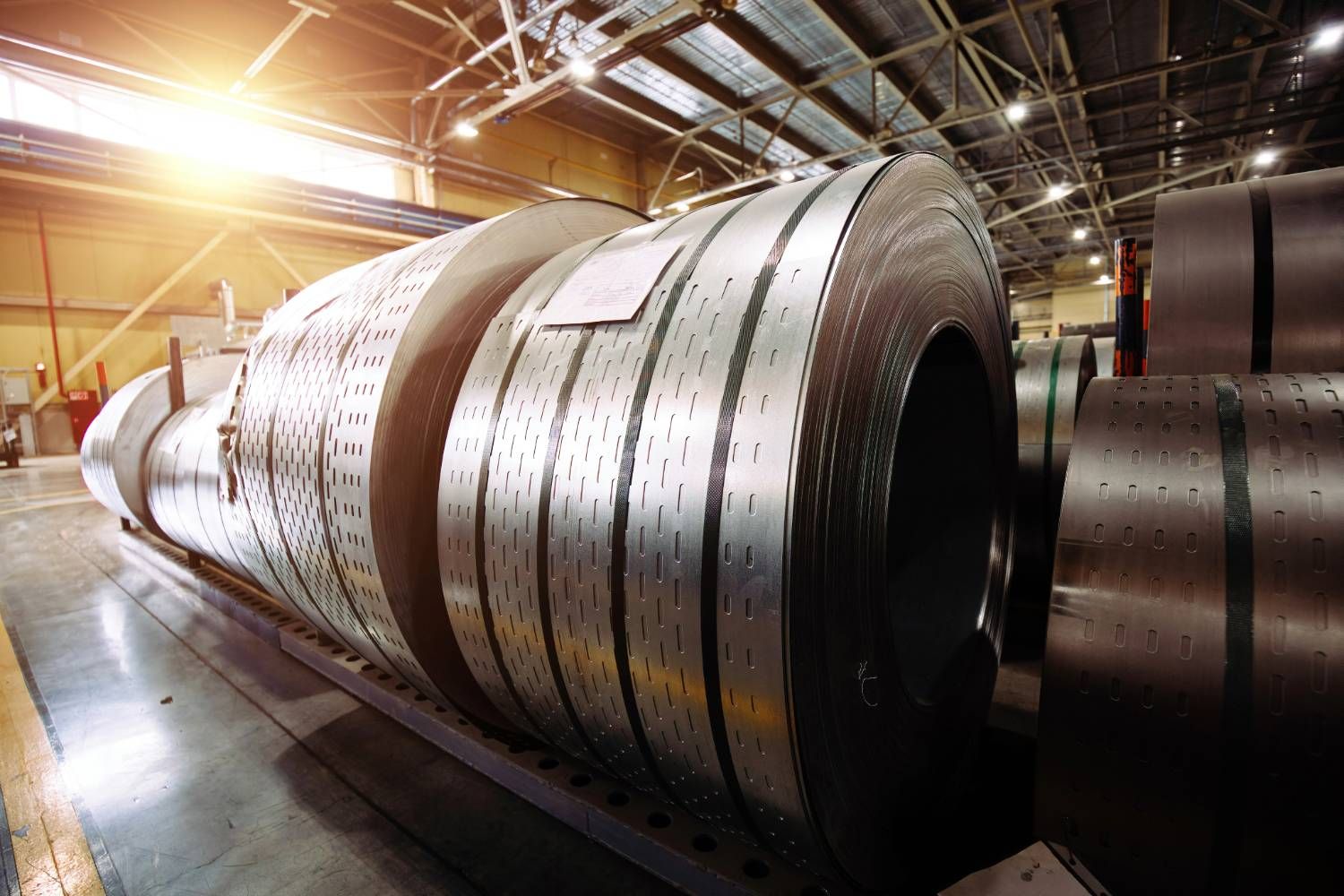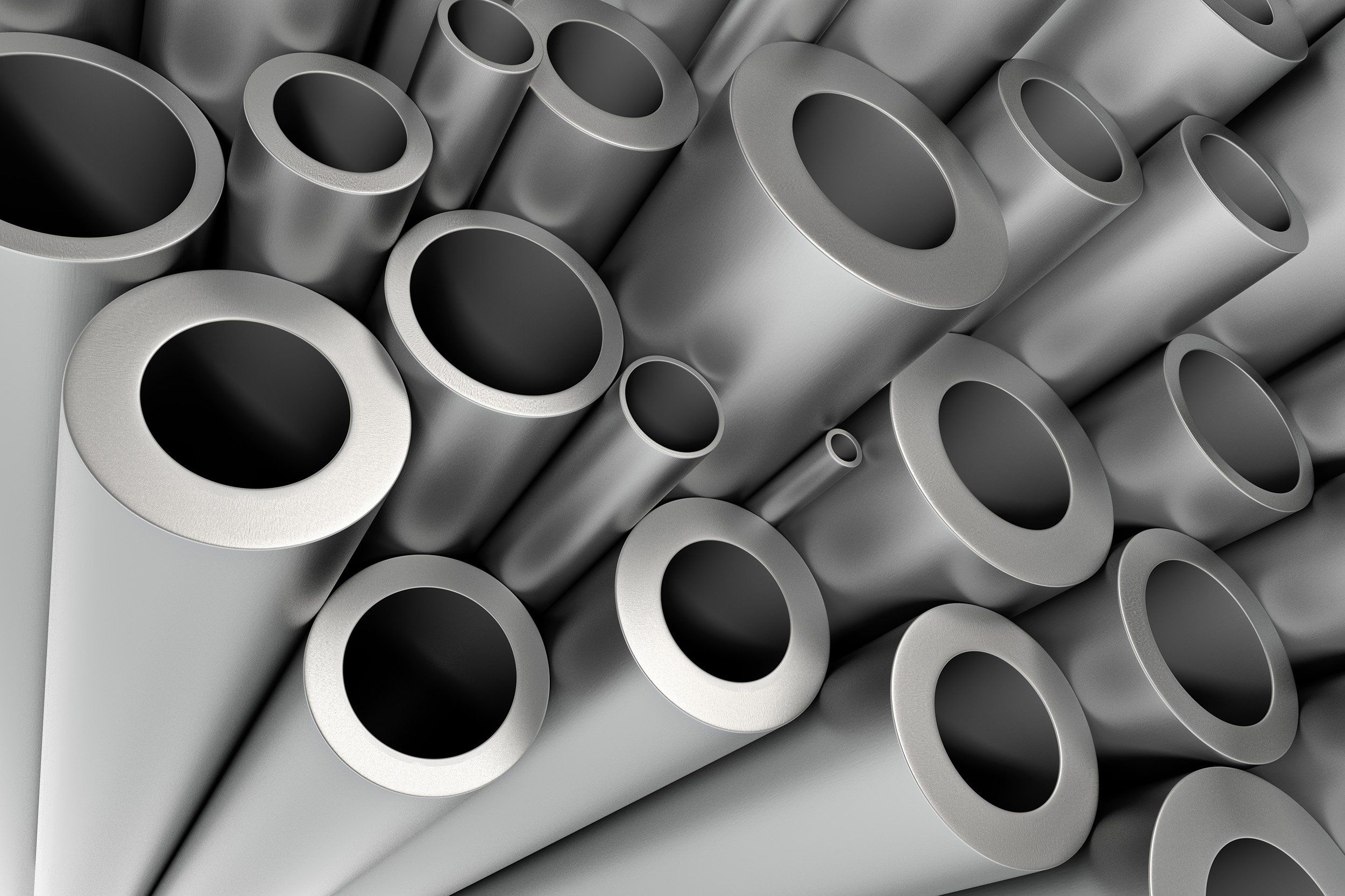
June 28, 2022
Rafaella Resources Limited (ASX:RFR) (‘Rafaella’ or the ‘Company’) is pleased to announce that assay results from three exploration diamond drillholes (‘DDH’) drilled, but never assayed, in 2015 by Valoriza Minería S.L.U. (‘Valoriza’) returned high tin grades from cassiterite mineralisation. These results will be included for the ongoing 3D geological model of the vein system and for a maiden JORC compliant Mineral Resource Estimate (MRE) for its 100% owned San Finx tin and tungsten mine1 (“San Finx”).
Investment Highlights
- Drillhole 15DDPN01 (PN01) was in the NE extreme of the main UG development of Pozo Nuevo zone, and it returned:
- 2.23% Sn over 1.50m, from 84.25m and
- 1.12% Sn over 1.10m, from 174.90m.
- Drillhole 15DDPN02 (PN02) tested depth extensions in the central part of Pozo Nuevo zone and intersected:
- 2.12% Sn over 1.60m, from 287.50m, undercutting level 8 of the UG development, proving continuity of the vein system and good grades at depth.
- Drillhole 15DDPN03 (PN03) was in the SW extreme of the main UG development of Pozo Nuevo zone, and it intersected:
- 0.73% WO3 over 1.00m from 244.90m,
- 0.55% Sn over 2.00m from 374.80 and
- 0.61% Sn over 1.00m from 436.40m.
- Cu assay returned an average grade of 0.30% Cu within the 0.25% Sn and W cut-off intervals, suggesting that the mine could generate copper concentrate by-product credits.
- San Finx was producing a clean concentrate of both tin and tungsten as recently as 2017.
Managing Director Steven Turner said: “These results confirm the exceptional grades of both tin and tungsten that are characteristic of this mine and underpin the attractiveness of restarting operations as soon as possible. San Finx is a historically producing mine with simple metallurgy and a track record of selling high-grade clean concentrates under contract. Work is continuing with the JORC compliant mineral resource estimate, and these results will be incorporated into that study. The Board looks forward to updating the market with the final report in Q3 2022.”
Assay results from 3 deep DDH, drilled by previous owners
Rafaella Resources has received assay data from the three DDH re-coded as 15DDPN01 (PN01), 15DDPN02 (PN02) and 15DDPN03 (PN03) which were drilled by Valoriza with the objective of expanding resources at depth for the underground operation. Figure 1 shows the location of the drillholes and of the underground development projections.
Figure 1. San Finx Sn-W deposit showing the mineralized zones at surface and the projection of the underground development for the zones of Buenaventura and Pozo Nuevo. Collar and projection of DDH PN01, PN02 and PN03.
Table 1 is showing drillhole coordinates, depth and downhole survey.
A total of 71 samples from the 3 DDH, including QA/QC (blanks, standards and duplicates from both, pulps, and coarse rejects) were submitted to ALS preparation laboratory in Seville.
All intercepts above 0.25% cut-off (combined Sn + WO3) have been calculated, as shown in table 2. True thickness factor has been applied according to the angles measured directly from core.
Cu assay returned an average grade of 0.30% Cu within the 0.25% Sn+WO3 cut-off intervals, suggesting that the mine could generate credits from a by-product sulphide concentrate.
The mineralised veins intersected generally correspond with the NE system, showing high core angles, Corrections ranging between 0.50 and 0.95 have been applied for the true thickness factor. Note that for the shallower mineralised veins intersected by DDH 15DDPN01, drilled in the NE extreme of the Pozo Nuevo Zone and that corresponds with the NNE trending Campelo-Silva vein system, the true thickness factor applied was much higher due to the low angle that such veins have been intersected.
Click here for the full ASX Release
This article includes content from Rafaella Resources Limited, licensed for the purpose of publishing on Investing News Australia. This article does not constitute financial product advice. It is your responsibility to perform proper due diligence before acting upon any information provided here. Please refer to our full disclaimer here.
RFR:AU
The Conversation (0)
23 December
Top 5 ASX Nickel Stocks of 2025
Although countries around the world have been adding nickel to their critical minerals lists, many nickel companies have faced difficulties due to a tough price environment.Nickel prices stagnated during the second half of 2025 as market surpluses met weak demand growth.Much of the supply... Keep Reading...
22 December
Nickel Price Forecast: Top Trends for Nickel in 2026
Nickel prices were stagnant in 2025, trading around US$15,000 per metric ton (MT) for much of the year.Weighing heavily on the metal was persistent oversupply from Indonesian operations. Meanwhile, sentiment remained weak amid soft demand growth from the construction and manufacturing sectors,... Keep Reading...
22 December
Lundin to Sell Eagle Nickel-Copper Mine and Humboldt Mill to Talon Metals
Lundin Mining (TSX:LUN,OTC Pink:LUNMF) has agreed to sell its Eagle mine and Humboldt mill in Michigan to Talon Metals (TSX:TLO,OTCID:TLOFF), pivoting its US-based operations to focus on domestic supply. The transaction will see Lundin Mining receive 275.2 million Talon shares, representing 18.4... Keep Reading...
19 December
Nickel Price 2025 Year-End Review
After peaking above US$20,000 per metric ton (MT) in May 2024, nickel prices have trended steadily down. Behind the numbers is persistent oversupply driven by high output from Indonesia, the world’s largest nickel producer. At the same time, demand from China's manufacturing and construction... Keep Reading...
01 December
Tartisan Nickel Corp. Acquires Apex Claims Contiguous to the Kenbridge Nickel Copper Cobalt Project, Northwestern, Ontario
Tartisan Nickel Corp. (CSE: TN,OTC:TTSRF) (OTCQB: TTSRF) (FSE: 8TA) ("Tartisan", or the "Company") is pleased to announce that it has completed the purchase of three claims historically identified as the "Apex Claims" located in the Atikwa Lake region, in the Kenora Mining District, Northwestern... Keep Reading...
03 November
Top 5 Canadian Nickel Stocks of 2025
Nickel prices have experienced volatility in the past few years due to supply and demand uncertainty. While demand has been consistent, prices have been mainly influenced by structural oversupply stemming from high output from Indonesia, which rapidly increased output in recent years to become... Keep Reading...
Latest News
Interactive Chart
Latest Press Releases
Related News
TOP STOCKS
American Battery4.030.24
Aion Therapeutic0.10-0.01
Cybin Corp2.140.00
